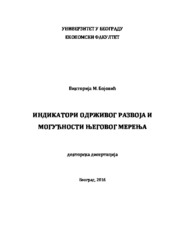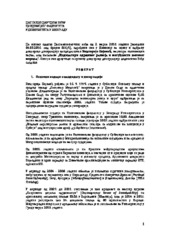Prikaz osnovnih podataka o disertaciji
Индикатори одрживог развоја и могућности његовог мерења
Indicators of sustainable development and the possibilities of measurement
| dc.contributor.advisor | Filipović, Milorad | |
| dc.creator | Bojović, Viktorija M. | |
| dc.date.accessioned | 2016-09-03T19:10:16Z | |
| dc.date.available | 2016-09-03T19:10:16Z | |
| dc.date.available | 2020-07-03T08:31:14Z | |
| dc.date.issued | 2016-07-14 | |
| dc.identifier.uri | http://eteze.bg.ac.rs/application/showtheses?thesesId=3786 | |
| dc.identifier.uri | https://nardus.mpn.gov.rs/handle/123456789/6400 | |
| dc.identifier.uri | https://fedorabg.bg.ac.rs/fedora/get/o:12726/bdef:Content/download | |
| dc.identifier.uri | http://vbs.rs/scripts/cobiss?command=DISPLAY&base=70036&RID=48154895 | |
| dc.description.abstract | Social sciences / economic development | |
| dc.description.abstract | Уобичајен начин мерења привредног успеха представља мерење привредног раста, као јединог циља економске политике базиране на постулатима неокласичне економије. Искључива посвећеност привредном расту на значају добија нарочито у периодима кризе када се једини излаз види искључиво у повољним индексима раста. Раст, као увећање материјалне базе, је неопходан како би се повећала запосленост, остварили предуслови за напредак и технолошка достигнућа. У сиромашном свету раст представља једини излаз из беде и свеопште немаштине. Друштвено благостање, загађење околине, па и социјално задовољство, постају лако занемарљиви зарад раста. За мерење привредног раста развијени су и у употреби су значајни показатељи, од којих су најзаступљенији макроекономски агрегати којима се сумирају привредне активности, међу којима предњачи бруто домаћи производ. Иако представља меру производње, а не дохотка, бруто домаћи производ се веома често користи као апроксимативна мера благостања, односно животног стандарда становништва које није монетарна категорија. Лакоћа примене и доступност података учинила је овај показатељ готово незаменљивим. Одрживи развој подразумева раст као излаз из сиромаштва и путању ка развијеном стању које се може одржати на веома дугачак период. У ефикасној привреди, раст или развој претпоставља одвајање ресурса од потрошње тренутне генерације зарад инвестиција које ће повећати продуктивност будуће генерације. Да би развој био одржив путања развоја привреде мора бити у оквиру еколошких и технолошких ограничења. | sr |
| dc.description.abstract | The standard way to measure economic success is by measuring economic growth, as the sole goal of the economic policy based on the principles of neoclassical economics. Exclusive orientation towards economic growth gains special importance in times of crises, when favourable growth indexes are seen as the only solution. Growth, together with the enlargement of the material base, is inevitable in order to increase employment and provide preconditions for development and technological advancement. In underdeveloped parts of the world, growth is the only way out of crisis and general poverty. Social welfare, environmental pollution and even social satisfaction are easily neglected in favor of growth. There are significant indicators available for measuring economic growth; the most widely used being macroeconomic aggregates that represent a sum of economic activity, with gross domestic product as the most prominent one. Even though it measures production rather than income, gross domestic product is often used as a proxy for welfare, i.e. the standard of living although a non-monetary value. Its ease of use and data availability are what makes this indicator almost indispensable. Sustainable development refers to growth as a means to ending poverty and taking the trajectory to a developed state that can be obtained for a very long period of time. In an efficient economy, growth or development means taking the resources from the current spending, in order to make investments that will increase the productivity of future generations. For development to be sustainable, the trajectory of economic development must remain within the limits of environmental and technological constraints. The problem of presenting the sustainability is of utmost importance, with several parameters having been defined to that effect, such as constant savings rate, constant capital to output ratio, balanced growth, constant pleasure, utility and so on. | en |
| dc.format | application/pdf | |
| dc.language | sr | |
| dc.publisher | Универзитет у Београду, Економски факултет | sr |
| dc.rights | openAccess | en |
| dc.rights.uri | https://creativecommons.org/licenses/by-nc-nd/4.0/ | |
| dc.source | Универзитет у Београду | sr |
| dc.subject | одрживи развој | sr |
| dc.subject | Sustainable Development | en |
| dc.subject | Sustainable Development Indicators | en |
| dc.subject | Sustainable Development Models | en |
| dc.subject | Economic Growth | en |
| dc.subject | индикатори одрживог развоја | sr |
| dc.subject | модели одрживог развоја | sr |
| dc.subject | економски раст | sr |
| dc.title | Индикатори одрживог развоја и могућности његовог мерења | sr |
| dc.title | Indicators of sustainable development and the possibilities of measurement | en |
| dc.type | doctoralThesis | en |
| dc.rights.license | BY-NC-ND | |
| dcterms.abstract | Филиповић, Милорад; Бојовић, Викторија М.; Indikatori održivog razvoja i mogućnosti njegovog merenja; | |
| dc.identifier.fulltext | http://nardus.mpn.gov.rs/bitstream/id/4636/Bojovic_Viktorija_M.pdf | |
| dc.identifier.fulltext | https://nardus.mpn.gov.rs/bitstream/id/4635/Disertacija4438.pdf | |
| dc.identifier.fulltext | https://nardus.mpn.gov.rs/bitstream/id/4636/Bojovic_Viktorija_M.pdf | |
| dc.identifier.fulltext | http://nardus.mpn.gov.rs/bitstream/id/4635/Disertacija4438.pdf | |
| dc.identifier.rcub | https://hdl.handle.net/21.15107/rcub_nardus_6400 |



